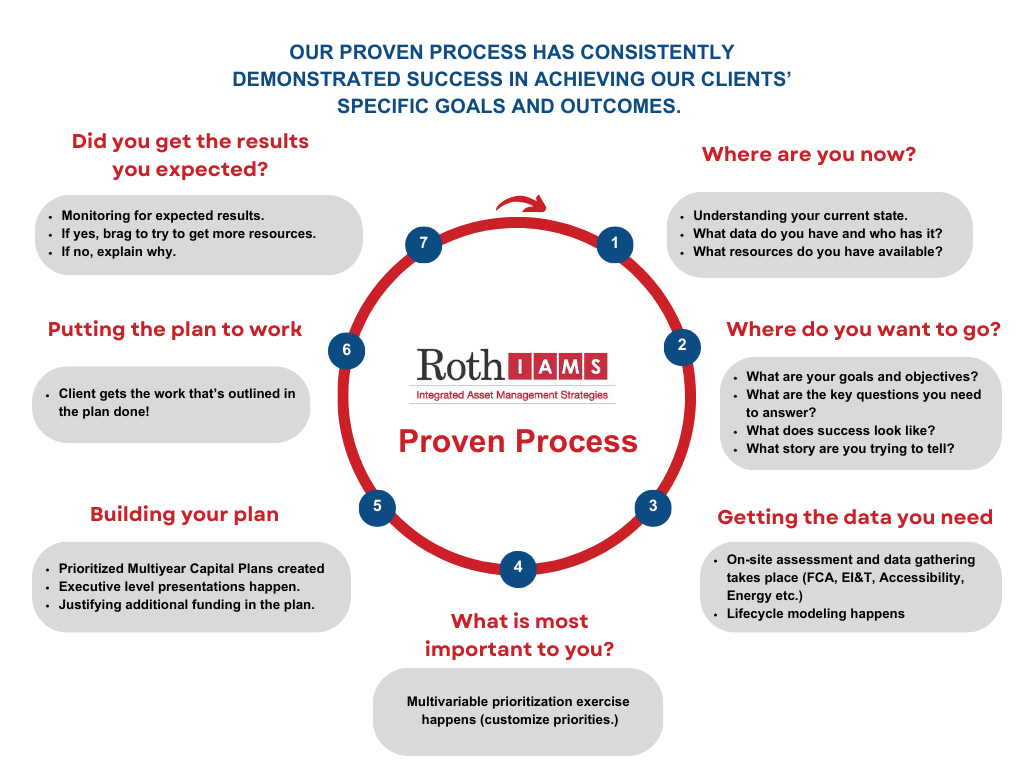We are your guides through the Asset Management Process. At Roth IAMS, our team of full-time experienced professionals include experts in all facility and infrastructure disciplines.
Traditional Asset Management has been executed through silos within organizations, with each department responsible for its own asset type (buildings, roads, water/wastewater, etc.) or a specific discipline associated with an asset and has focused on short term vs. long term goals. Based on our experience, this approach results in lost opportunity for asset and financial optimization.
We believe that by collaborating with all stakeholders, an integrated strategy will result in a more efficient and effective allocation of capital dollars, while leveraging assets towards the overall goals of our client.
Click on each circle to learn more about each step of the asset management process.
To support the business-focus of any Asset Management Framework, it must be founded on current and long-term BUSINESS OBJECTIVES AND PROCESSES. All decisions and plans must further the overall client objectives and be feasible within the corporate structure that is driven by business processes. In addition, while it is important to ensure tactical strategies to address near-term needs are formed, it is also critical to ensure that the focus on the long-term strategies is not forgotten.

DATA is the integral part of understanding any issue related to an existing asset, whether that be condition data, regulatory/code liability, performance, space utilization, energy consumption, etc. For an organization to determine the optimal data required, it needs to focus on the desired project outcome(s). The type of data collected, the necessary level of detail, and the team or teams responsible for collecting it will all impact the downstream ability to plan based on the data, and the overall project costs. For this project to be successful, the project team must understand the current state of data, and to develop a framework going-forward to allow data collection to be done in alignment with our client’s existing Asset Management Framework. The foundation of any sustainable buildings program is the comparison of the performance or design of capital assets against current industry standards and best practices. What gets measured can be managed. The collection of the appropriate data can allow for benchmarking of current performance, the establishment of reasonable targets for improvement, and the monitoring of progress towards these goals.
TOOLS: With a clear picture of the type and amount of data that will be required, the next critical factor is related to the tools that will be used to store, manage and manipulate the data. If the dataset is relatively limited a spreadsheet may meet a client’s functionality needs. However, for a large, complex set of data, or where sophisticated prioritization and business case development is required, more robust tools will be required to provide the desired analysis.
PRIORITIZATION: The Competition for Capital continues to increase for portfolio owners/managers as assets age, energy/resource prices rise, and government regulation becomes more intense. The simplistic “High, Medium and Low” prioritization methodologies employed are no longer sufficient to manage portfolio risks. Almost all organizations have a significant deferred maintenance backlog and lack the capital required to address even its “High” needs, not to mention Medium or Low priorities. As such, for complex, diverse portfolios we recommend a more robust priority scheme based on weightings and algorithms supported by overall corporate business objectives. In this way mission critical assets can rightly access higher levels of funding than support assets. Demographics, functional adequacy, energy performance and other key issues that impact business can be built into the priority scheme.
BUDGETING: At this stage of the process, we shift from a highly technical focus (collecting, managing and manipulating building data) that is generally within the comfort zone of the staff responsible for the maintaining the assets and who have a grasp of its complexity. To effectively communicate with the senior executives who will fund the asset management program it is vital that we “translate” all the technical data into a high-level financial and risk-based discussion.
DESIGN EXECUTION AND MONITORING: With the technical requirements clearly communicated, budgets in-place it is time to move the program forward from the planning stage to the design and construction phases. There are two areas of focus that are sometimes overlooked during renewal projects, which are critical to the development of an on-going asset management program. These are commissioning and post project operational monitoring.
Commissioning provides confirmation that the mechanical systems have been installed and are operating as they were designed and should allow for the achievement of the overall goals of the proposed work plan. Post-project operational monitoring also provides additional data to demonstrate that a project achieves the specific results (e.g. energy savings, improved ventilation, etc.) it was designed to. Each of these processes creates additional data that can be fed back into the framework at the foundation to allow for on-going asset management.
